Service Quality Dimensions Analysis in Hotel & Hospitality Management
VerifiedAdded on 2023/06/15
|11
|2776
|66
Report
AI Summary
This report provides a comprehensive service quality analysis of a fine dining restaurant, utilizing customer and employee feedback to identify key issues impacting reputation and revenue. It examines service quality dimensions such as responsiveness, assurance, tangibles, empathy, and reliability, highlighting gaps between customer expectations and experiences. The report identifies issues from both customer and employee perspectives, including communication gaps, staff behavior, pricing concerns, and internal conflicts. Existing service management strategies are evaluated for effectiveness, and recommendations are provided to improve service quality, focusing on internal team resolution, clear hiring criteria, skill development, and enhanced customer service guidelines. The ultimate goal is to improve overall service quality and customer satisfaction.
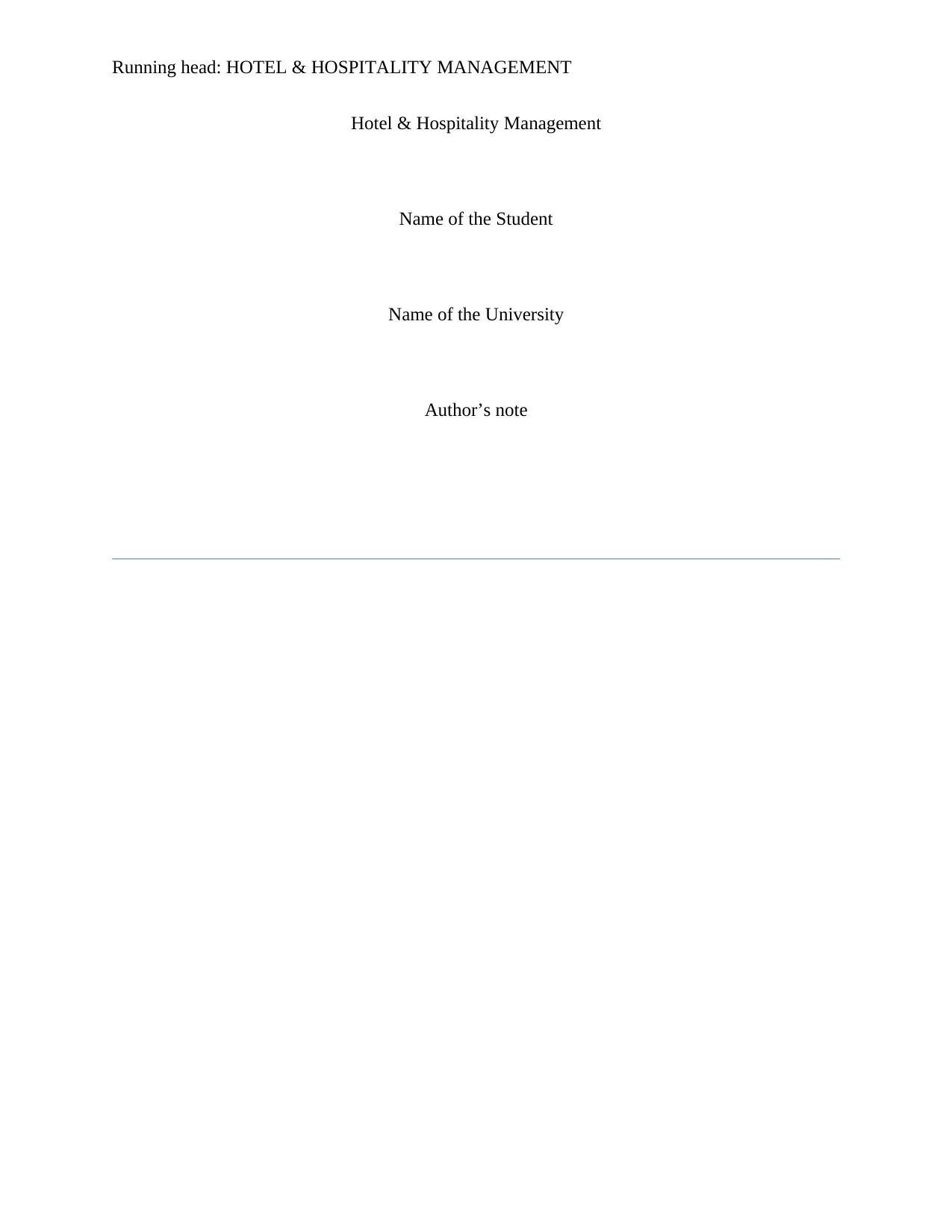
Running head: HOTEL & HOSPITALITY MANAGEMENT
Hotel & Hospitality Management
Name of the Student
Name of the University
Author’s note
Hotel & Hospitality Management
Name of the Student
Name of the University
Author’s note
Paraphrase This Document
Need a fresh take? Get an instant paraphrase of this document with our AI Paraphraser
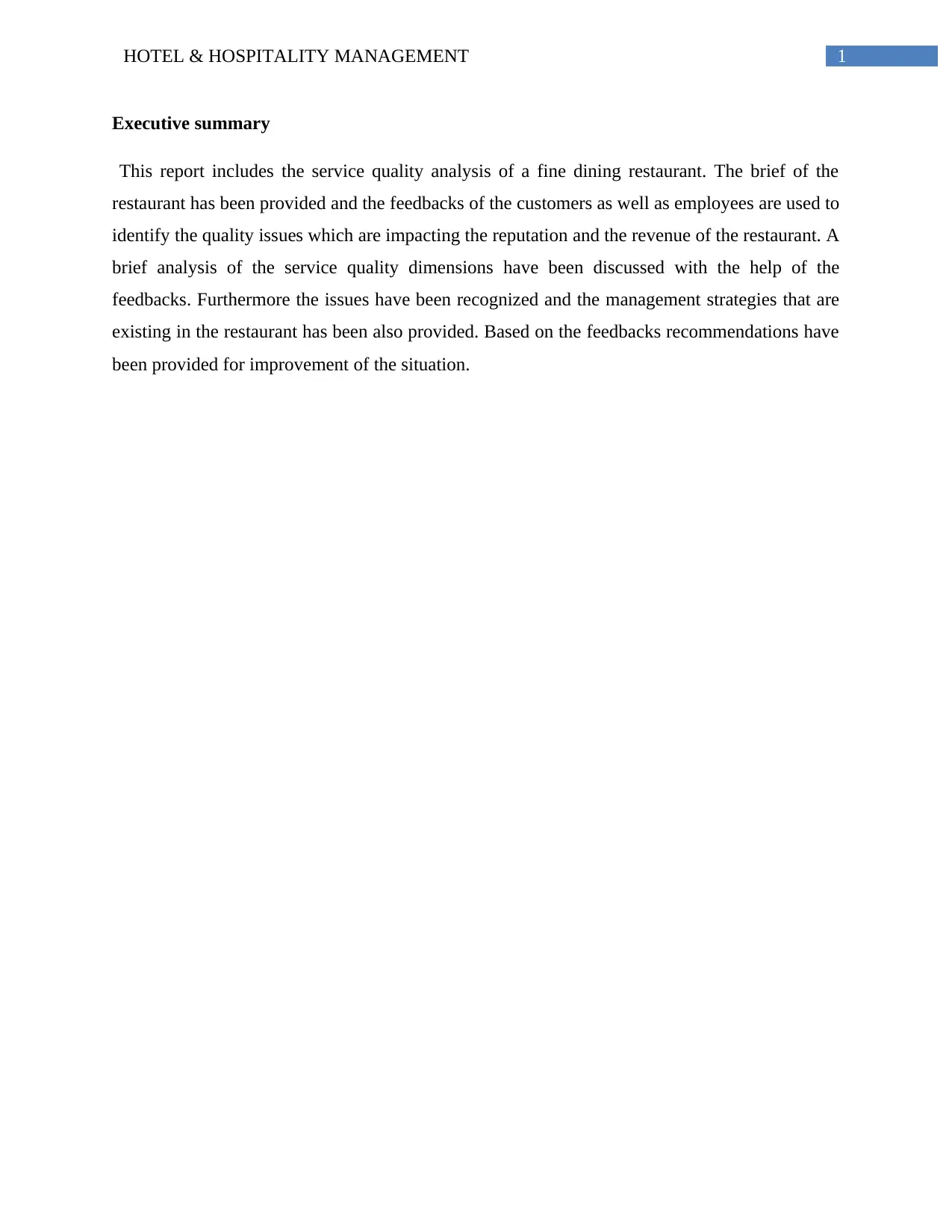
1HOTEL & HOSPITALITY MANAGEMENT
Executive summary
This report includes the service quality analysis of a fine dining restaurant. The brief of the
restaurant has been provided and the feedbacks of the customers as well as employees are used to
identify the quality issues which are impacting the reputation and the revenue of the restaurant. A
brief analysis of the service quality dimensions have been discussed with the help of the
feedbacks. Furthermore the issues have been recognized and the management strategies that are
existing in the restaurant has been also provided. Based on the feedbacks recommendations have
been provided for improvement of the situation.
Executive summary
This report includes the service quality analysis of a fine dining restaurant. The brief of the
restaurant has been provided and the feedbacks of the customers as well as employees are used to
identify the quality issues which are impacting the reputation and the revenue of the restaurant. A
brief analysis of the service quality dimensions have been discussed with the help of the
feedbacks. Furthermore the issues have been recognized and the management strategies that are
existing in the restaurant has been also provided. Based on the feedbacks recommendations have
been provided for improvement of the situation.
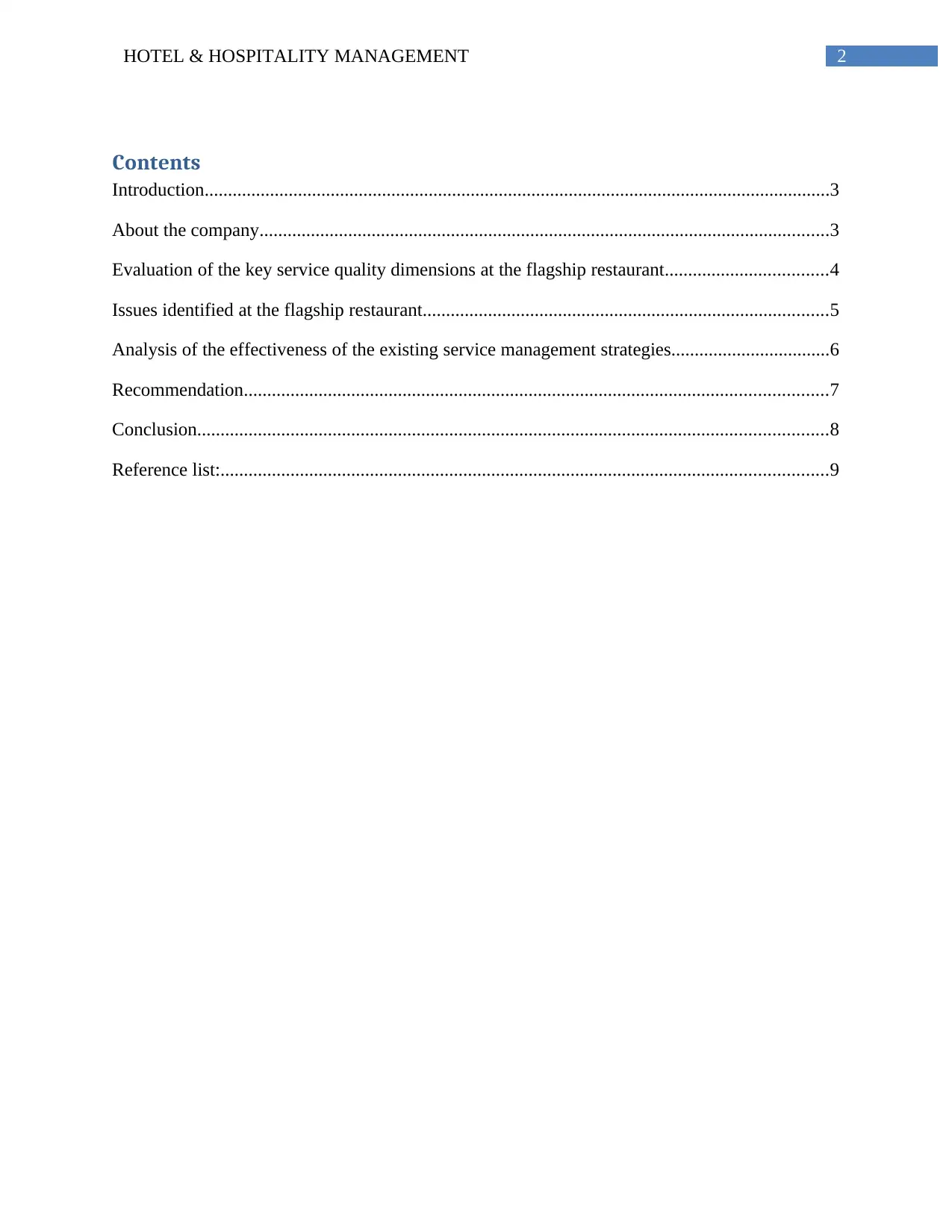
2HOTEL & HOSPITALITY MANAGEMENT
Contents
Introduction......................................................................................................................................3
About the company..........................................................................................................................3
Evaluation of the key service quality dimensions at the flagship restaurant...................................4
Issues identified at the flagship restaurant.......................................................................................5
Analysis of the effectiveness of the existing service management strategies..................................6
Recommendation.............................................................................................................................7
Conclusion.......................................................................................................................................8
Reference list:..................................................................................................................................9
Contents
Introduction......................................................................................................................................3
About the company..........................................................................................................................3
Evaluation of the key service quality dimensions at the flagship restaurant...................................4
Issues identified at the flagship restaurant.......................................................................................5
Analysis of the effectiveness of the existing service management strategies..................................6
Recommendation.............................................................................................................................7
Conclusion.......................................................................................................................................8
Reference list:..................................................................................................................................9
⊘ This is a preview!⊘
Do you want full access?
Subscribe today to unlock all pages.

Trusted by 1+ million students worldwide
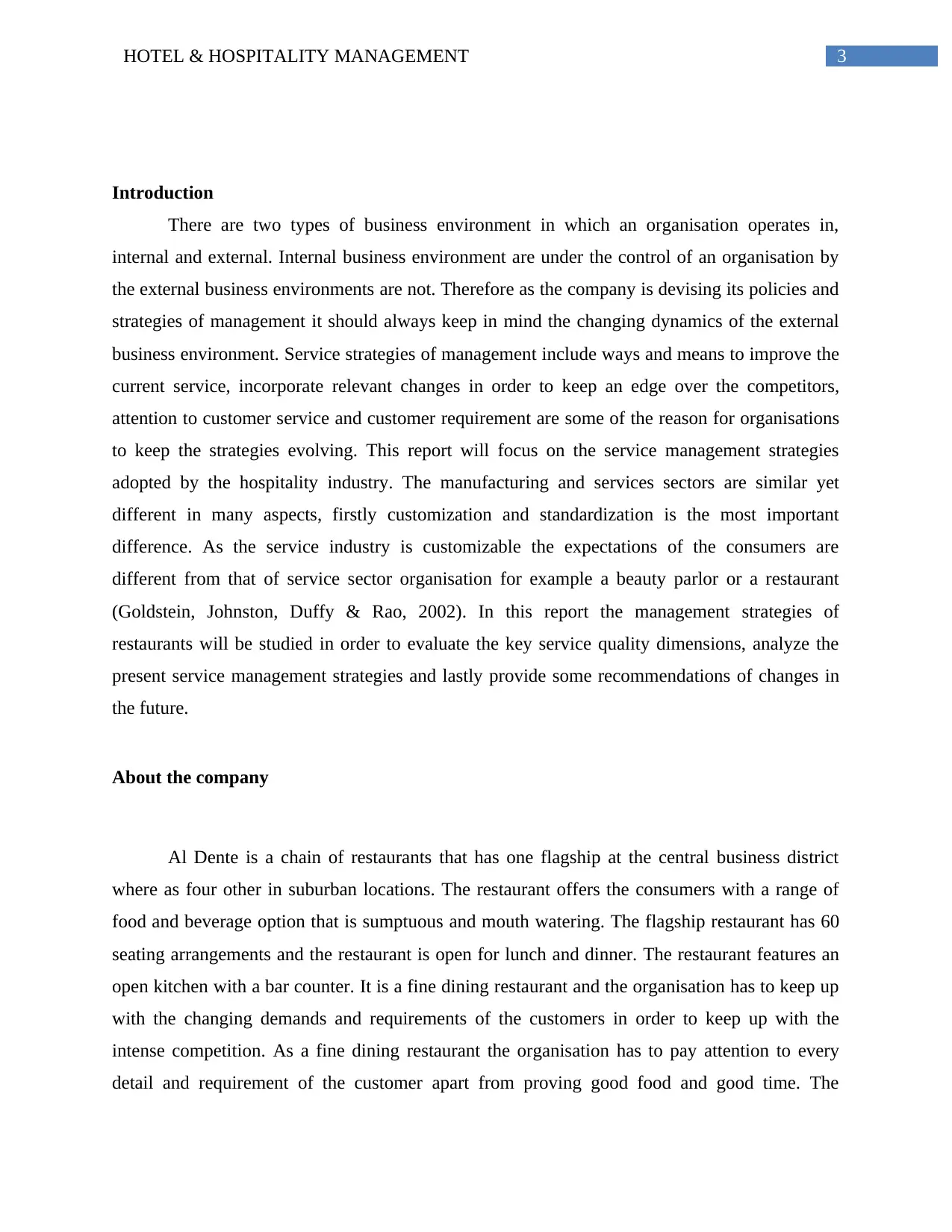
3HOTEL & HOSPITALITY MANAGEMENT
Introduction
There are two types of business environment in which an organisation operates in,
internal and external. Internal business environment are under the control of an organisation by
the external business environments are not. Therefore as the company is devising its policies and
strategies of management it should always keep in mind the changing dynamics of the external
business environment. Service strategies of management include ways and means to improve the
current service, incorporate relevant changes in order to keep an edge over the competitors,
attention to customer service and customer requirement are some of the reason for organisations
to keep the strategies evolving. This report will focus on the service management strategies
adopted by the hospitality industry. The manufacturing and services sectors are similar yet
different in many aspects, firstly customization and standardization is the most important
difference. As the service industry is customizable the expectations of the consumers are
different from that of service sector organisation for example a beauty parlor or a restaurant
(Goldstein, Johnston, Duffy & Rao, 2002). In this report the management strategies of
restaurants will be studied in order to evaluate the key service quality dimensions, analyze the
present service management strategies and lastly provide some recommendations of changes in
the future.
About the company
Al Dente is a chain of restaurants that has one flagship at the central business district
where as four other in suburban locations. The restaurant offers the consumers with a range of
food and beverage option that is sumptuous and mouth watering. The flagship restaurant has 60
seating arrangements and the restaurant is open for lunch and dinner. The restaurant features an
open kitchen with a bar counter. It is a fine dining restaurant and the organisation has to keep up
with the changing demands and requirements of the customers in order to keep up with the
intense competition. As a fine dining restaurant the organisation has to pay attention to every
detail and requirement of the customer apart from proving good food and good time. The
Introduction
There are two types of business environment in which an organisation operates in,
internal and external. Internal business environment are under the control of an organisation by
the external business environments are not. Therefore as the company is devising its policies and
strategies of management it should always keep in mind the changing dynamics of the external
business environment. Service strategies of management include ways and means to improve the
current service, incorporate relevant changes in order to keep an edge over the competitors,
attention to customer service and customer requirement are some of the reason for organisations
to keep the strategies evolving. This report will focus on the service management strategies
adopted by the hospitality industry. The manufacturing and services sectors are similar yet
different in many aspects, firstly customization and standardization is the most important
difference. As the service industry is customizable the expectations of the consumers are
different from that of service sector organisation for example a beauty parlor or a restaurant
(Goldstein, Johnston, Duffy & Rao, 2002). In this report the management strategies of
restaurants will be studied in order to evaluate the key service quality dimensions, analyze the
present service management strategies and lastly provide some recommendations of changes in
the future.
About the company
Al Dente is a chain of restaurants that has one flagship at the central business district
where as four other in suburban locations. The restaurant offers the consumers with a range of
food and beverage option that is sumptuous and mouth watering. The flagship restaurant has 60
seating arrangements and the restaurant is open for lunch and dinner. The restaurant features an
open kitchen with a bar counter. It is a fine dining restaurant and the organisation has to keep up
with the changing demands and requirements of the customers in order to keep up with the
intense competition. As a fine dining restaurant the organisation has to pay attention to every
detail and requirement of the customer apart from proving good food and good time. The
Paraphrase This Document
Need a fresh take? Get an instant paraphrase of this document with our AI Paraphraser
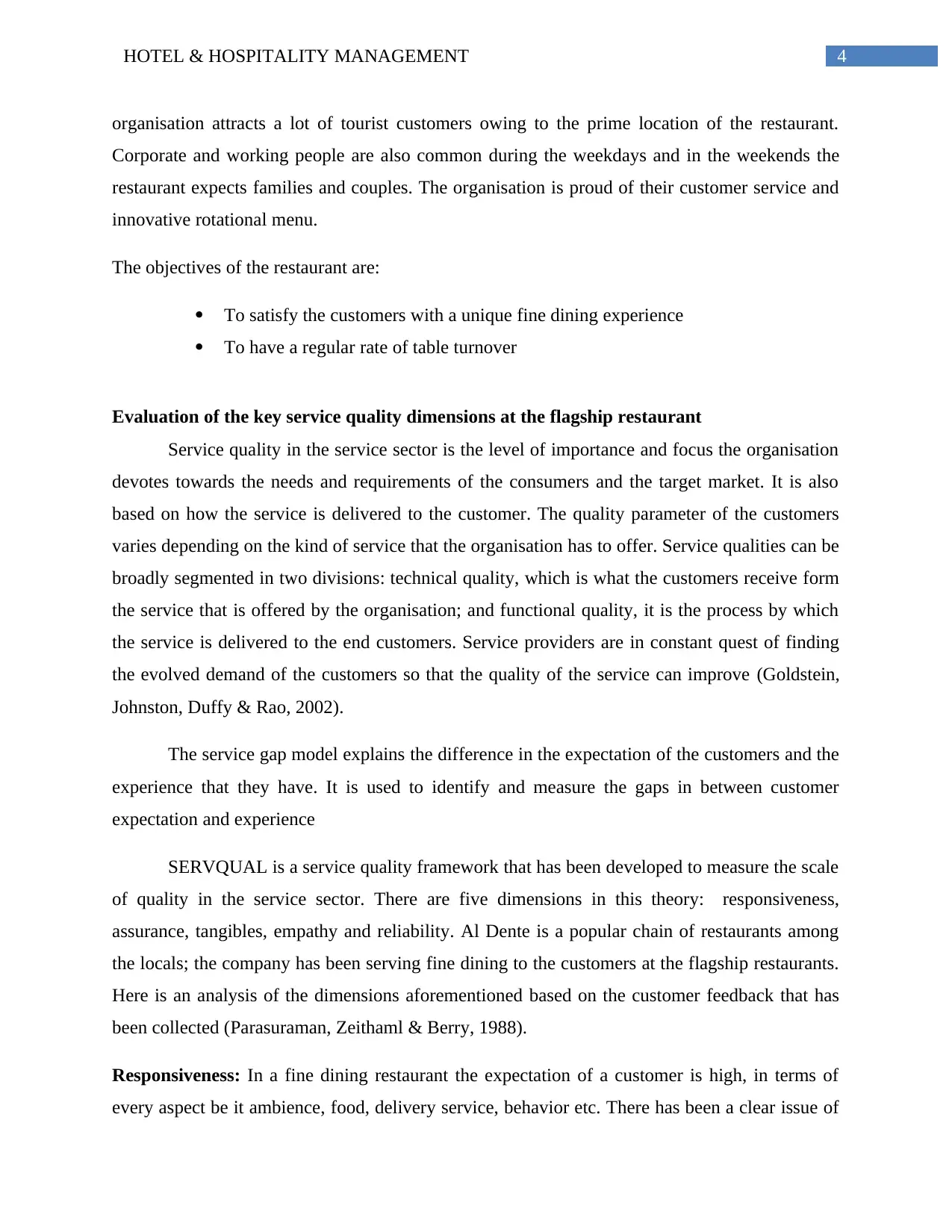
4HOTEL & HOSPITALITY MANAGEMENT
organisation attracts a lot of tourist customers owing to the prime location of the restaurant.
Corporate and working people are also common during the weekdays and in the weekends the
restaurant expects families and couples. The organisation is proud of their customer service and
innovative rotational menu.
The objectives of the restaurant are:
To satisfy the customers with a unique fine dining experience
To have a regular rate of table turnover
Evaluation of the key service quality dimensions at the flagship restaurant
Service quality in the service sector is the level of importance and focus the organisation
devotes towards the needs and requirements of the consumers and the target market. It is also
based on how the service is delivered to the customer. The quality parameter of the customers
varies depending on the kind of service that the organisation has to offer. Service qualities can be
broadly segmented in two divisions: technical quality, which is what the customers receive form
the service that is offered by the organisation; and functional quality, it is the process by which
the service is delivered to the end customers. Service providers are in constant quest of finding
the evolved demand of the customers so that the quality of the service can improve (Goldstein,
Johnston, Duffy & Rao, 2002).
The service gap model explains the difference in the expectation of the customers and the
experience that they have. It is used to identify and measure the gaps in between customer
expectation and experience
SERVQUAL is a service quality framework that has been developed to measure the scale
of quality in the service sector. There are five dimensions in this theory: responsiveness,
assurance, tangibles, empathy and reliability. Al Dente is a popular chain of restaurants among
the locals; the company has been serving fine dining to the customers at the flagship restaurants.
Here is an analysis of the dimensions aforementioned based on the customer feedback that has
been collected (Parasuraman, Zeithaml & Berry, 1988).
Responsiveness: In a fine dining restaurant the expectation of a customer is high, in terms of
every aspect be it ambience, food, delivery service, behavior etc. There has been a clear issue of
organisation attracts a lot of tourist customers owing to the prime location of the restaurant.
Corporate and working people are also common during the weekdays and in the weekends the
restaurant expects families and couples. The organisation is proud of their customer service and
innovative rotational menu.
The objectives of the restaurant are:
To satisfy the customers with a unique fine dining experience
To have a regular rate of table turnover
Evaluation of the key service quality dimensions at the flagship restaurant
Service quality in the service sector is the level of importance and focus the organisation
devotes towards the needs and requirements of the consumers and the target market. It is also
based on how the service is delivered to the customer. The quality parameter of the customers
varies depending on the kind of service that the organisation has to offer. Service qualities can be
broadly segmented in two divisions: technical quality, which is what the customers receive form
the service that is offered by the organisation; and functional quality, it is the process by which
the service is delivered to the end customers. Service providers are in constant quest of finding
the evolved demand of the customers so that the quality of the service can improve (Goldstein,
Johnston, Duffy & Rao, 2002).
The service gap model explains the difference in the expectation of the customers and the
experience that they have. It is used to identify and measure the gaps in between customer
expectation and experience
SERVQUAL is a service quality framework that has been developed to measure the scale
of quality in the service sector. There are five dimensions in this theory: responsiveness,
assurance, tangibles, empathy and reliability. Al Dente is a popular chain of restaurants among
the locals; the company has been serving fine dining to the customers at the flagship restaurants.
Here is an analysis of the dimensions aforementioned based on the customer feedback that has
been collected (Parasuraman, Zeithaml & Berry, 1988).
Responsiveness: In a fine dining restaurant the expectation of a customer is high, in terms of
every aspect be it ambience, food, delivery service, behavior etc. There has been a clear issue of
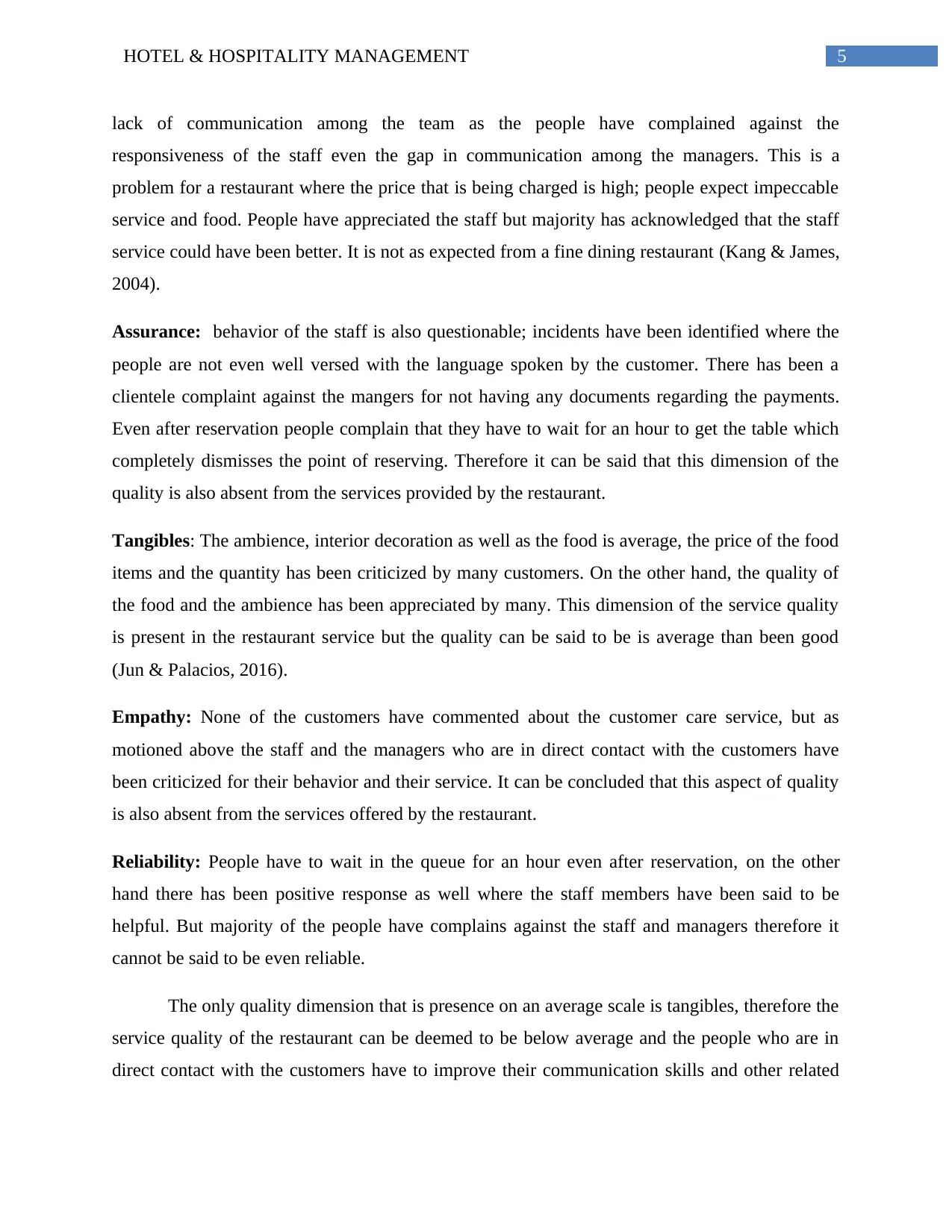
5HOTEL & HOSPITALITY MANAGEMENT
lack of communication among the team as the people have complained against the
responsiveness of the staff even the gap in communication among the managers. This is a
problem for a restaurant where the price that is being charged is high; people expect impeccable
service and food. People have appreciated the staff but majority has acknowledged that the staff
service could have been better. It is not as expected from a fine dining restaurant (Kang & James,
2004).
Assurance: behavior of the staff is also questionable; incidents have been identified where the
people are not even well versed with the language spoken by the customer. There has been a
clientele complaint against the mangers for not having any documents regarding the payments.
Even after reservation people complain that they have to wait for an hour to get the table which
completely dismisses the point of reserving. Therefore it can be said that this dimension of the
quality is also absent from the services provided by the restaurant.
Tangibles: The ambience, interior decoration as well as the food is average, the price of the food
items and the quantity has been criticized by many customers. On the other hand, the quality of
the food and the ambience has been appreciated by many. This dimension of the service quality
is present in the restaurant service but the quality can be said to be is average than been good
(Jun & Palacios, 2016).
Empathy: None of the customers have commented about the customer care service, but as
motioned above the staff and the managers who are in direct contact with the customers have
been criticized for their behavior and their service. It can be concluded that this aspect of quality
is also absent from the services offered by the restaurant.
Reliability: People have to wait in the queue for an hour even after reservation, on the other
hand there has been positive response as well where the staff members have been said to be
helpful. But majority of the people have complains against the staff and managers therefore it
cannot be said to be even reliable.
The only quality dimension that is presence on an average scale is tangibles, therefore the
service quality of the restaurant can be deemed to be below average and the people who are in
direct contact with the customers have to improve their communication skills and other related
lack of communication among the team as the people have complained against the
responsiveness of the staff even the gap in communication among the managers. This is a
problem for a restaurant where the price that is being charged is high; people expect impeccable
service and food. People have appreciated the staff but majority has acknowledged that the staff
service could have been better. It is not as expected from a fine dining restaurant (Kang & James,
2004).
Assurance: behavior of the staff is also questionable; incidents have been identified where the
people are not even well versed with the language spoken by the customer. There has been a
clientele complaint against the mangers for not having any documents regarding the payments.
Even after reservation people complain that they have to wait for an hour to get the table which
completely dismisses the point of reserving. Therefore it can be said that this dimension of the
quality is also absent from the services provided by the restaurant.
Tangibles: The ambience, interior decoration as well as the food is average, the price of the food
items and the quantity has been criticized by many customers. On the other hand, the quality of
the food and the ambience has been appreciated by many. This dimension of the service quality
is present in the restaurant service but the quality can be said to be is average than been good
(Jun & Palacios, 2016).
Empathy: None of the customers have commented about the customer care service, but as
motioned above the staff and the managers who are in direct contact with the customers have
been criticized for their behavior and their service. It can be concluded that this aspect of quality
is also absent from the services offered by the restaurant.
Reliability: People have to wait in the queue for an hour even after reservation, on the other
hand there has been positive response as well where the staff members have been said to be
helpful. But majority of the people have complains against the staff and managers therefore it
cannot be said to be even reliable.
The only quality dimension that is presence on an average scale is tangibles, therefore the
service quality of the restaurant can be deemed to be below average and the people who are in
direct contact with the customers have to improve their communication skills and other related
⊘ This is a preview!⊘
Do you want full access?
Subscribe today to unlock all pages.

Trusted by 1+ million students worldwide
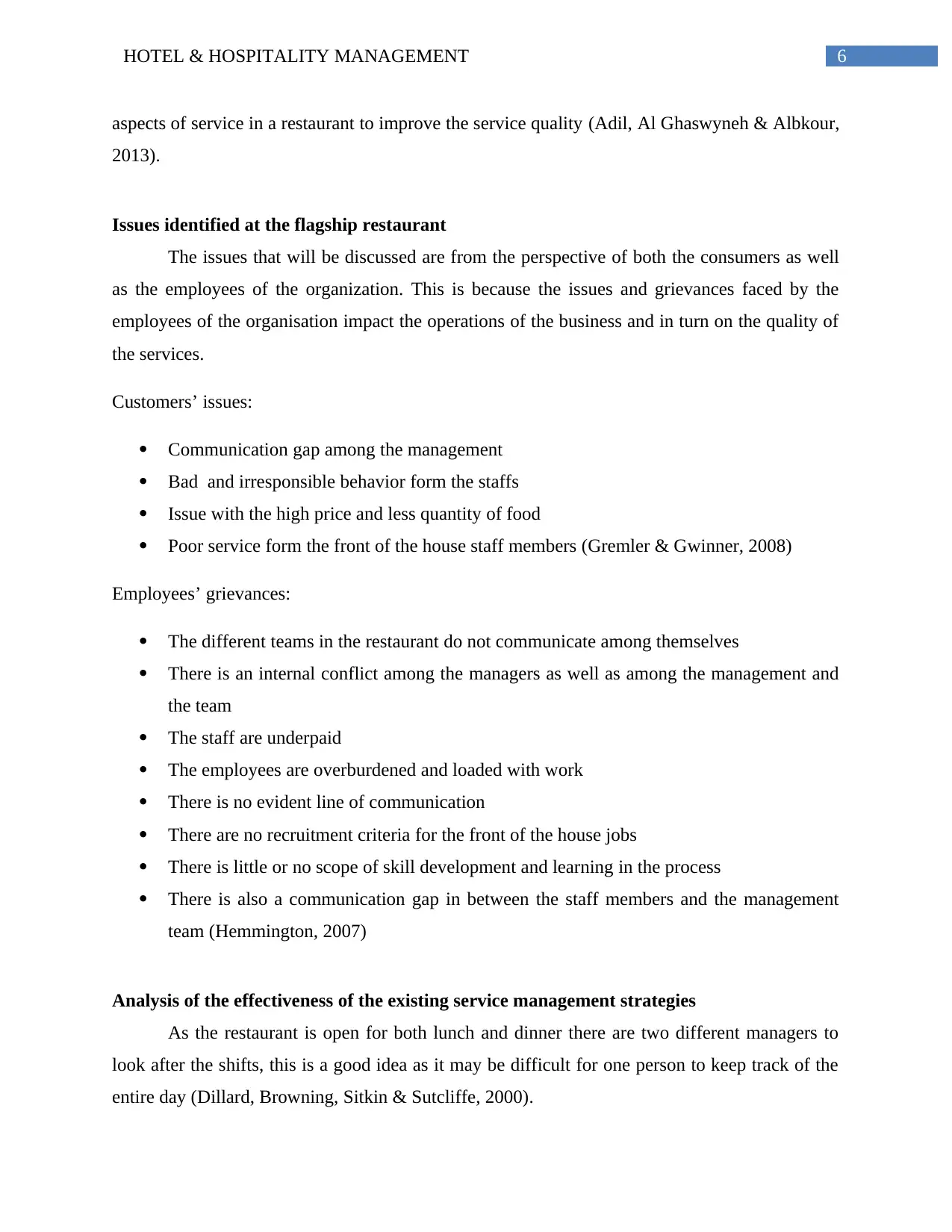
6HOTEL & HOSPITALITY MANAGEMENT
aspects of service in a restaurant to improve the service quality (Adil, Al Ghaswyneh & Albkour,
2013).
Issues identified at the flagship restaurant
The issues that will be discussed are from the perspective of both the consumers as well
as the employees of the organization. This is because the issues and grievances faced by the
employees of the organisation impact the operations of the business and in turn on the quality of
the services.
Customers’ issues:
Communication gap among the management
Bad and irresponsible behavior form the staffs
Issue with the high price and less quantity of food
Poor service form the front of the house staff members (Gremler & Gwinner, 2008)
Employees’ grievances:
The different teams in the restaurant do not communicate among themselves
There is an internal conflict among the managers as well as among the management and
the team
The staff are underpaid
The employees are overburdened and loaded with work
There is no evident line of communication
There are no recruitment criteria for the front of the house jobs
There is little or no scope of skill development and learning in the process
There is also a communication gap in between the staff members and the management
team (Hemmington, 2007)
Analysis of the effectiveness of the existing service management strategies
As the restaurant is open for both lunch and dinner there are two different managers to
look after the shifts, this is a good idea as it may be difficult for one person to keep track of the
entire day (Dillard, Browning, Sitkin & Sutcliffe, 2000).
aspects of service in a restaurant to improve the service quality (Adil, Al Ghaswyneh & Albkour,
2013).
Issues identified at the flagship restaurant
The issues that will be discussed are from the perspective of both the consumers as well
as the employees of the organization. This is because the issues and grievances faced by the
employees of the organisation impact the operations of the business and in turn on the quality of
the services.
Customers’ issues:
Communication gap among the management
Bad and irresponsible behavior form the staffs
Issue with the high price and less quantity of food
Poor service form the front of the house staff members (Gremler & Gwinner, 2008)
Employees’ grievances:
The different teams in the restaurant do not communicate among themselves
There is an internal conflict among the managers as well as among the management and
the team
The staff are underpaid
The employees are overburdened and loaded with work
There is no evident line of communication
There are no recruitment criteria for the front of the house jobs
There is little or no scope of skill development and learning in the process
There is also a communication gap in between the staff members and the management
team (Hemmington, 2007)
Analysis of the effectiveness of the existing service management strategies
As the restaurant is open for both lunch and dinner there are two different managers to
look after the shifts, this is a good idea as it may be difficult for one person to keep track of the
entire day (Dillard, Browning, Sitkin & Sutcliffe, 2000).
Paraphrase This Document
Need a fresh take? Get an instant paraphrase of this document with our AI Paraphraser
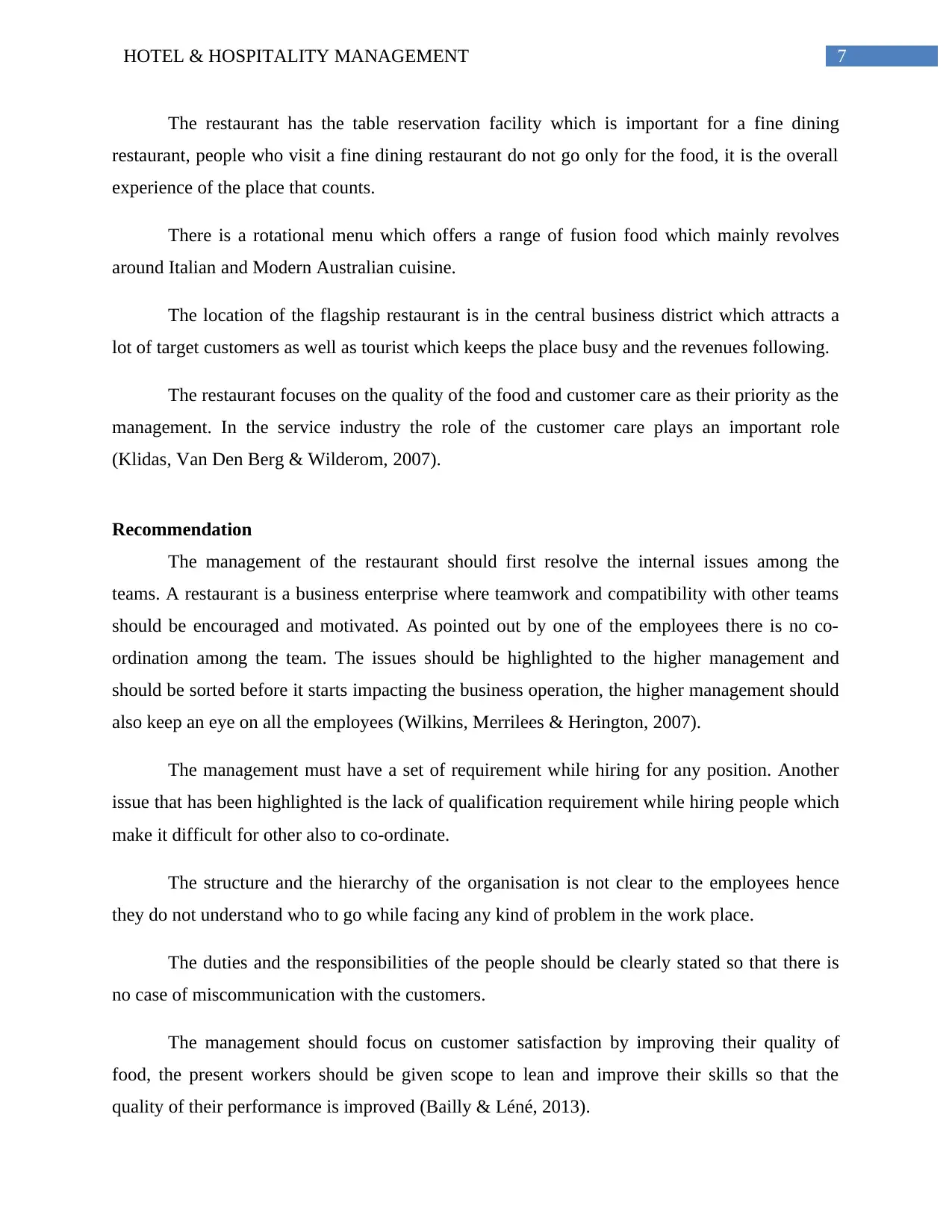
7HOTEL & HOSPITALITY MANAGEMENT
The restaurant has the table reservation facility which is important for a fine dining
restaurant, people who visit a fine dining restaurant do not go only for the food, it is the overall
experience of the place that counts.
There is a rotational menu which offers a range of fusion food which mainly revolves
around Italian and Modern Australian cuisine.
The location of the flagship restaurant is in the central business district which attracts a
lot of target customers as well as tourist which keeps the place busy and the revenues following.
The restaurant focuses on the quality of the food and customer care as their priority as the
management. In the service industry the role of the customer care plays an important role
(Klidas, Van Den Berg & Wilderom, 2007).
Recommendation
The management of the restaurant should first resolve the internal issues among the
teams. A restaurant is a business enterprise where teamwork and compatibility with other teams
should be encouraged and motivated. As pointed out by one of the employees there is no co-
ordination among the team. The issues should be highlighted to the higher management and
should be sorted before it starts impacting the business operation, the higher management should
also keep an eye on all the employees (Wilkins, Merrilees & Herington, 2007).
The management must have a set of requirement while hiring for any position. Another
issue that has been highlighted is the lack of qualification requirement while hiring people which
make it difficult for other also to co-ordinate.
The structure and the hierarchy of the organisation is not clear to the employees hence
they do not understand who to go while facing any kind of problem in the work place.
The duties and the responsibilities of the people should be clearly stated so that there is
no case of miscommunication with the customers.
The management should focus on customer satisfaction by improving their quality of
food, the present workers should be given scope to lean and improve their skills so that the
quality of their performance is improved (Bailly & Léné, 2013).
The restaurant has the table reservation facility which is important for a fine dining
restaurant, people who visit a fine dining restaurant do not go only for the food, it is the overall
experience of the place that counts.
There is a rotational menu which offers a range of fusion food which mainly revolves
around Italian and Modern Australian cuisine.
The location of the flagship restaurant is in the central business district which attracts a
lot of target customers as well as tourist which keeps the place busy and the revenues following.
The restaurant focuses on the quality of the food and customer care as their priority as the
management. In the service industry the role of the customer care plays an important role
(Klidas, Van Den Berg & Wilderom, 2007).
Recommendation
The management of the restaurant should first resolve the internal issues among the
teams. A restaurant is a business enterprise where teamwork and compatibility with other teams
should be encouraged and motivated. As pointed out by one of the employees there is no co-
ordination among the team. The issues should be highlighted to the higher management and
should be sorted before it starts impacting the business operation, the higher management should
also keep an eye on all the employees (Wilkins, Merrilees & Herington, 2007).
The management must have a set of requirement while hiring for any position. Another
issue that has been highlighted is the lack of qualification requirement while hiring people which
make it difficult for other also to co-ordinate.
The structure and the hierarchy of the organisation is not clear to the employees hence
they do not understand who to go while facing any kind of problem in the work place.
The duties and the responsibilities of the people should be clearly stated so that there is
no case of miscommunication with the customers.
The management should focus on customer satisfaction by improving their quality of
food, the present workers should be given scope to lean and improve their skills so that the
quality of their performance is improved (Bailly & Léné, 2013).
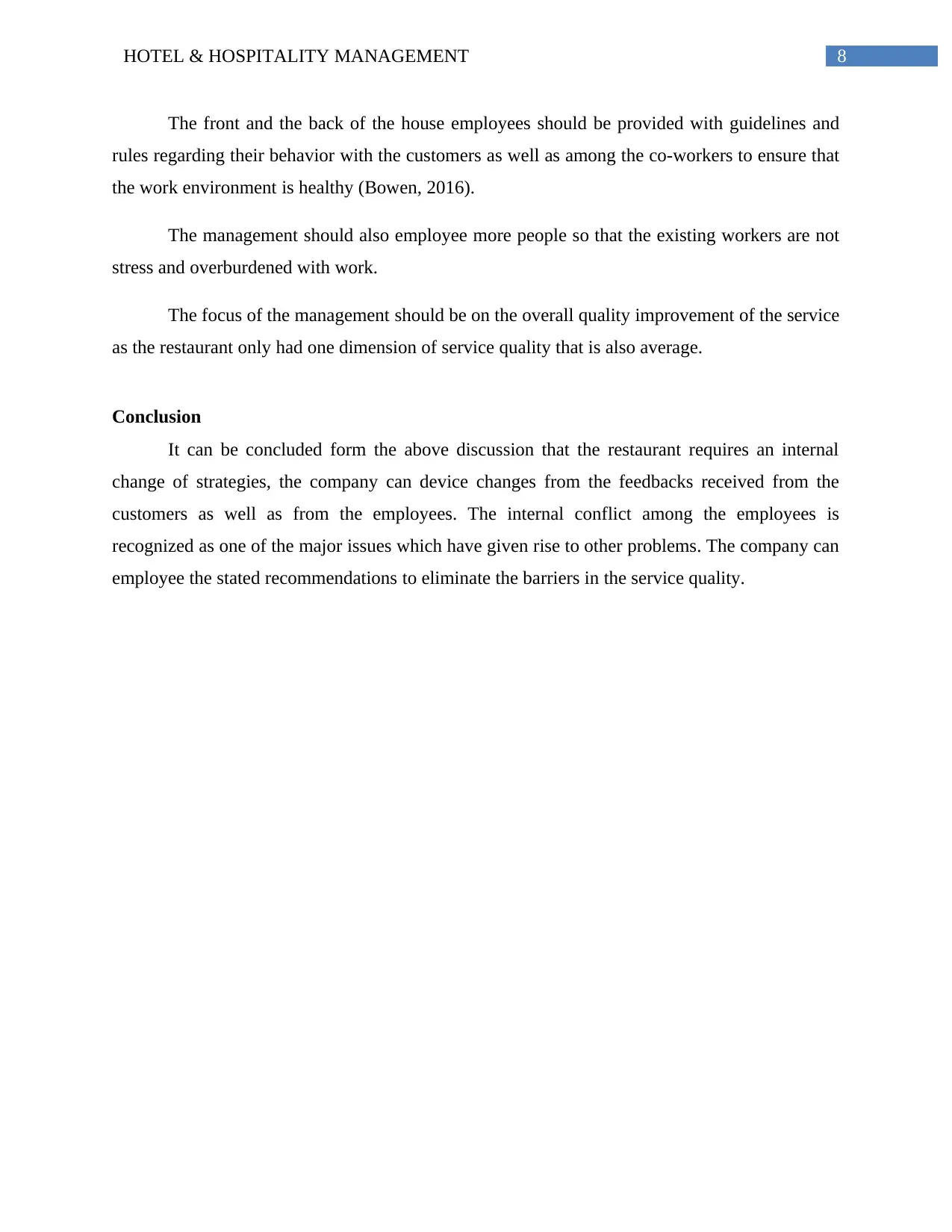
8HOTEL & HOSPITALITY MANAGEMENT
The front and the back of the house employees should be provided with guidelines and
rules regarding their behavior with the customers as well as among the co-workers to ensure that
the work environment is healthy (Bowen, 2016).
The management should also employee more people so that the existing workers are not
stress and overburdened with work.
The focus of the management should be on the overall quality improvement of the service
as the restaurant only had one dimension of service quality that is also average.
Conclusion
It can be concluded form the above discussion that the restaurant requires an internal
change of strategies, the company can device changes from the feedbacks received from the
customers as well as from the employees. The internal conflict among the employees is
recognized as one of the major issues which have given rise to other problems. The company can
employee the stated recommendations to eliminate the barriers in the service quality.
The front and the back of the house employees should be provided with guidelines and
rules regarding their behavior with the customers as well as among the co-workers to ensure that
the work environment is healthy (Bowen, 2016).
The management should also employee more people so that the existing workers are not
stress and overburdened with work.
The focus of the management should be on the overall quality improvement of the service
as the restaurant only had one dimension of service quality that is also average.
Conclusion
It can be concluded form the above discussion that the restaurant requires an internal
change of strategies, the company can device changes from the feedbacks received from the
customers as well as from the employees. The internal conflict among the employees is
recognized as one of the major issues which have given rise to other problems. The company can
employee the stated recommendations to eliminate the barriers in the service quality.
⊘ This is a preview!⊘
Do you want full access?
Subscribe today to unlock all pages.

Trusted by 1+ million students worldwide
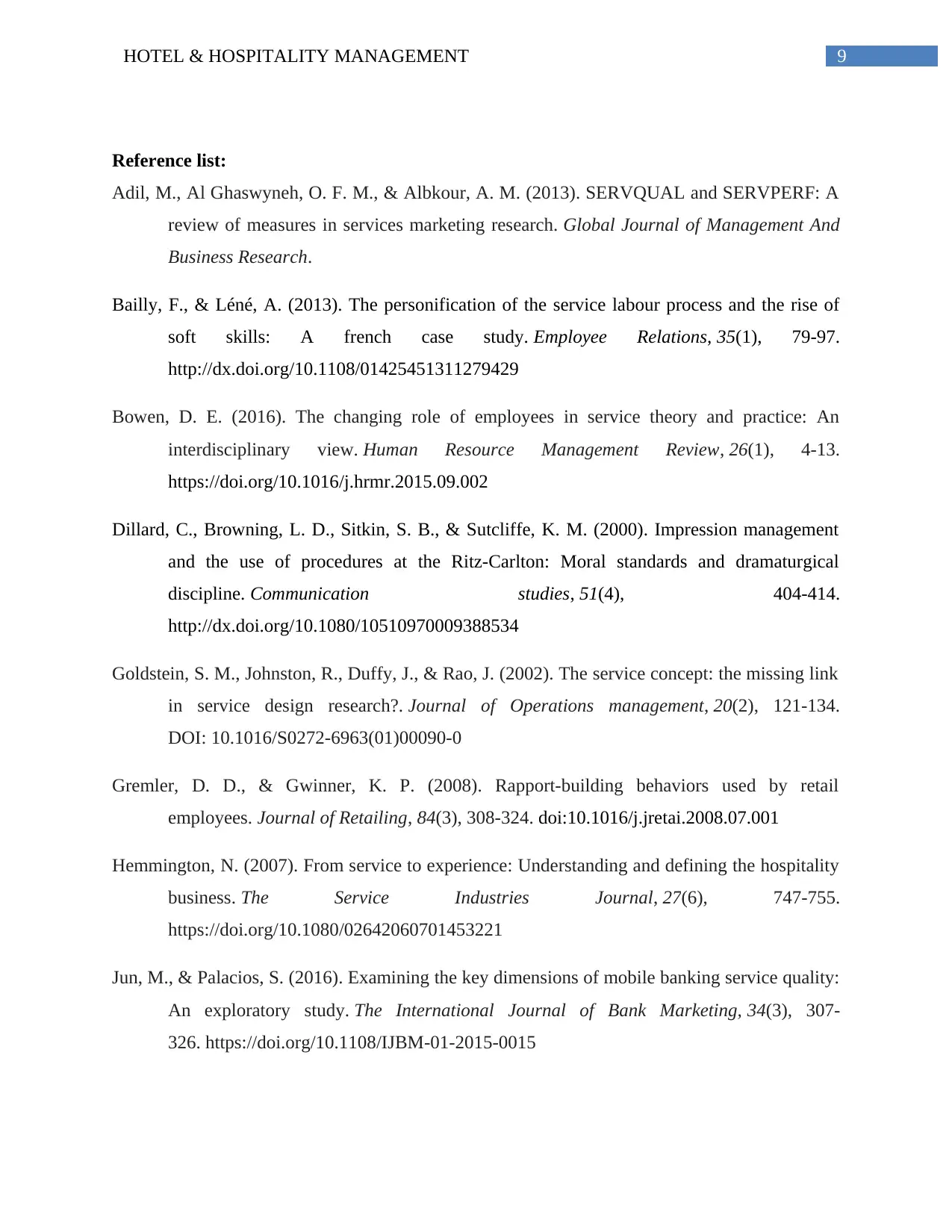
9HOTEL & HOSPITALITY MANAGEMENT
Reference list:
Adil, M., Al Ghaswyneh, O. F. M., & Albkour, A. M. (2013). SERVQUAL and SERVPERF: A
review of measures in services marketing research. Global Journal of Management And
Business Research.
Bailly, F., & Léné, A. (2013). The personification of the service labour process and the rise of
soft skills: A french case study. Employee Relations, 35(1), 79-97.
http://dx.doi.org/10.1108/01425451311279429
Bowen, D. E. (2016). The changing role of employees in service theory and practice: An
interdisciplinary view. Human Resource Management Review, 26(1), 4-13.
https://doi.org/10.1016/j.hrmr.2015.09.002
Dillard, C., Browning, L. D., Sitkin, S. B., & Sutcliffe, K. M. (2000). Impression management
and the use of procedures at the Ritz‐Carlton: Moral standards and dramaturgical
discipline. Communication studies, 51(4), 404-414.
http://dx.doi.org/10.1080/10510970009388534
Goldstein, S. M., Johnston, R., Duffy, J., & Rao, J. (2002). The service concept: the missing link
in service design research?. Journal of Operations management, 20(2), 121-134.
DOI: 10.1016/S0272-6963(01)00090-0
Gremler, D. D., & Gwinner, K. P. (2008). Rapport-building behaviors used by retail
employees. Journal of Retailing, 84(3), 308-324. doi:10.1016/j.jretai.2008.07.001
Hemmington, N. (2007). From service to experience: Understanding and defining the hospitality
business. The Service Industries Journal, 27(6), 747-755.
https://doi.org/10.1080/02642060701453221
Jun, M., & Palacios, S. (2016). Examining the key dimensions of mobile banking service quality:
An exploratory study. The International Journal of Bank Marketing, 34(3), 307-
326. https://doi.org/10.1108/IJBM-01-2015-0015
Reference list:
Adil, M., Al Ghaswyneh, O. F. M., & Albkour, A. M. (2013). SERVQUAL and SERVPERF: A
review of measures in services marketing research. Global Journal of Management And
Business Research.
Bailly, F., & Léné, A. (2013). The personification of the service labour process and the rise of
soft skills: A french case study. Employee Relations, 35(1), 79-97.
http://dx.doi.org/10.1108/01425451311279429
Bowen, D. E. (2016). The changing role of employees in service theory and practice: An
interdisciplinary view. Human Resource Management Review, 26(1), 4-13.
https://doi.org/10.1016/j.hrmr.2015.09.002
Dillard, C., Browning, L. D., Sitkin, S. B., & Sutcliffe, K. M. (2000). Impression management
and the use of procedures at the Ritz‐Carlton: Moral standards and dramaturgical
discipline. Communication studies, 51(4), 404-414.
http://dx.doi.org/10.1080/10510970009388534
Goldstein, S. M., Johnston, R., Duffy, J., & Rao, J. (2002). The service concept: the missing link
in service design research?. Journal of Operations management, 20(2), 121-134.
DOI: 10.1016/S0272-6963(01)00090-0
Gremler, D. D., & Gwinner, K. P. (2008). Rapport-building behaviors used by retail
employees. Journal of Retailing, 84(3), 308-324. doi:10.1016/j.jretai.2008.07.001
Hemmington, N. (2007). From service to experience: Understanding and defining the hospitality
business. The Service Industries Journal, 27(6), 747-755.
https://doi.org/10.1080/02642060701453221
Jun, M., & Palacios, S. (2016). Examining the key dimensions of mobile banking service quality:
An exploratory study. The International Journal of Bank Marketing, 34(3), 307-
326. https://doi.org/10.1108/IJBM-01-2015-0015
Paraphrase This Document
Need a fresh take? Get an instant paraphrase of this document with our AI Paraphraser
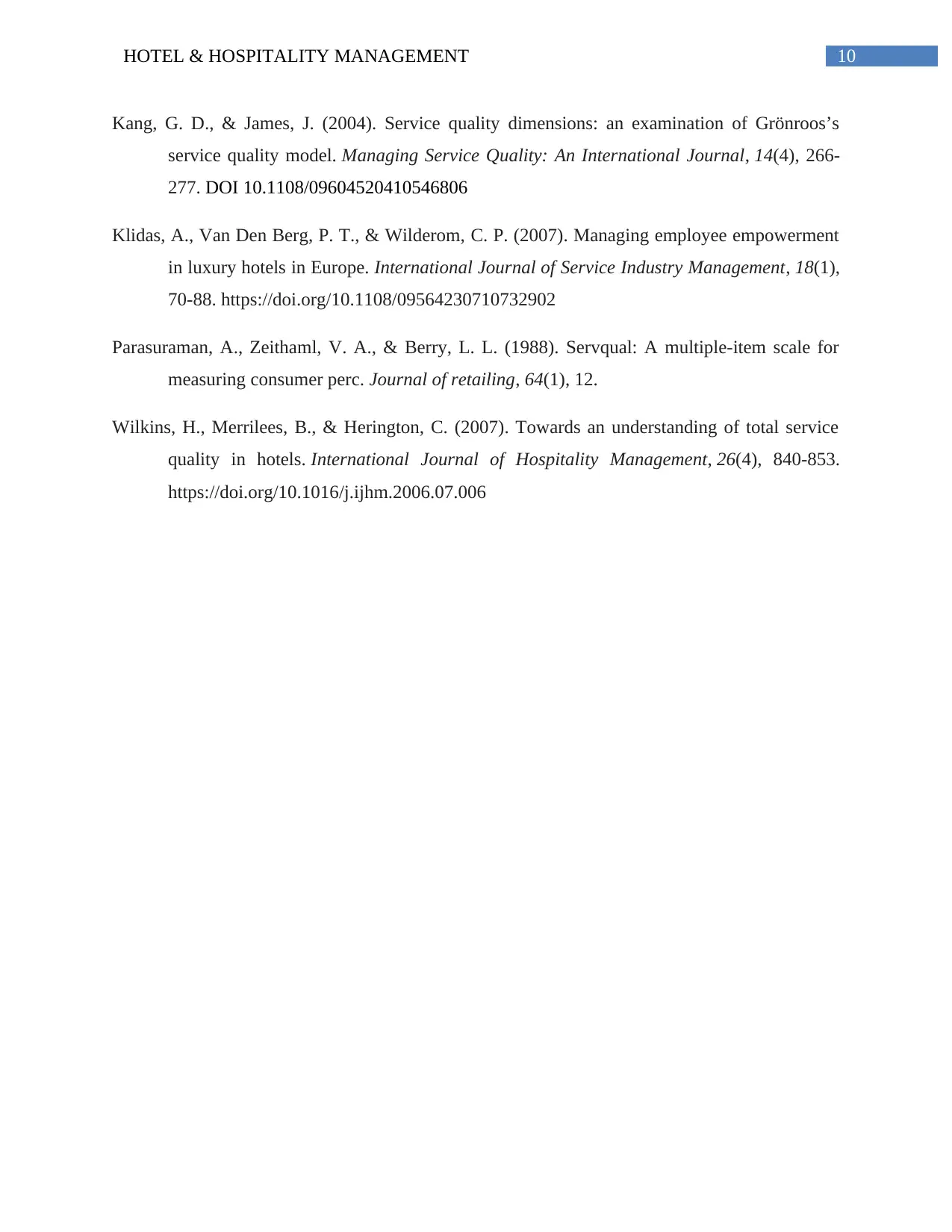
10HOTEL & HOSPITALITY MANAGEMENT
Kang, G. D., & James, J. (2004). Service quality dimensions: an examination of Grönroos’s
service quality model. Managing Service Quality: An International Journal, 14(4), 266-
277. DOI 10.1108/09604520410546806
Klidas, A., Van Den Berg, P. T., & Wilderom, C. P. (2007). Managing employee empowerment
in luxury hotels in Europe. International Journal of Service Industry Management, 18(1),
70-88. https://doi.org/10.1108/09564230710732902
Parasuraman, A., Zeithaml, V. A., & Berry, L. L. (1988). Servqual: A multiple-item scale for
measuring consumer perc. Journal of retailing, 64(1), 12.
Wilkins, H., Merrilees, B., & Herington, C. (2007). Towards an understanding of total service
quality in hotels. International Journal of Hospitality Management, 26(4), 840-853.
https://doi.org/10.1016/j.ijhm.2006.07.006
Kang, G. D., & James, J. (2004). Service quality dimensions: an examination of Grönroos’s
service quality model. Managing Service Quality: An International Journal, 14(4), 266-
277. DOI 10.1108/09604520410546806
Klidas, A., Van Den Berg, P. T., & Wilderom, C. P. (2007). Managing employee empowerment
in luxury hotels in Europe. International Journal of Service Industry Management, 18(1),
70-88. https://doi.org/10.1108/09564230710732902
Parasuraman, A., Zeithaml, V. A., & Berry, L. L. (1988). Servqual: A multiple-item scale for
measuring consumer perc. Journal of retailing, 64(1), 12.
Wilkins, H., Merrilees, B., & Herington, C. (2007). Towards an understanding of total service
quality in hotels. International Journal of Hospitality Management, 26(4), 840-853.
https://doi.org/10.1016/j.ijhm.2006.07.006
1 out of 11
Related Documents
Your All-in-One AI-Powered Toolkit for Academic Success.
+13062052269
info@desklib.com
Available 24*7 on WhatsApp / Email
![[object Object]](/_next/static/media/star-bottom.7253800d.svg)
Unlock your academic potential
Copyright © 2020–2025 A2Z Services. All Rights Reserved. Developed and managed by ZUCOL.





